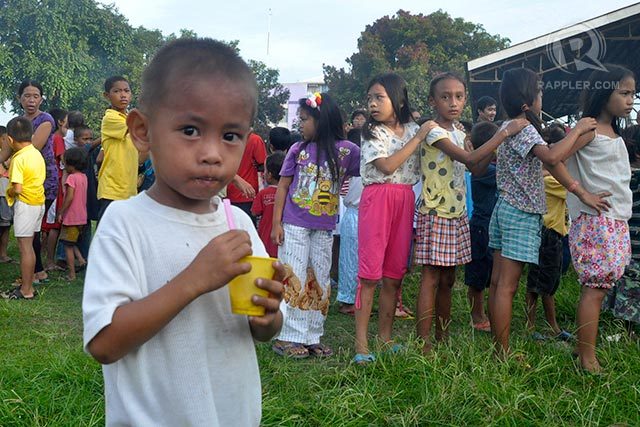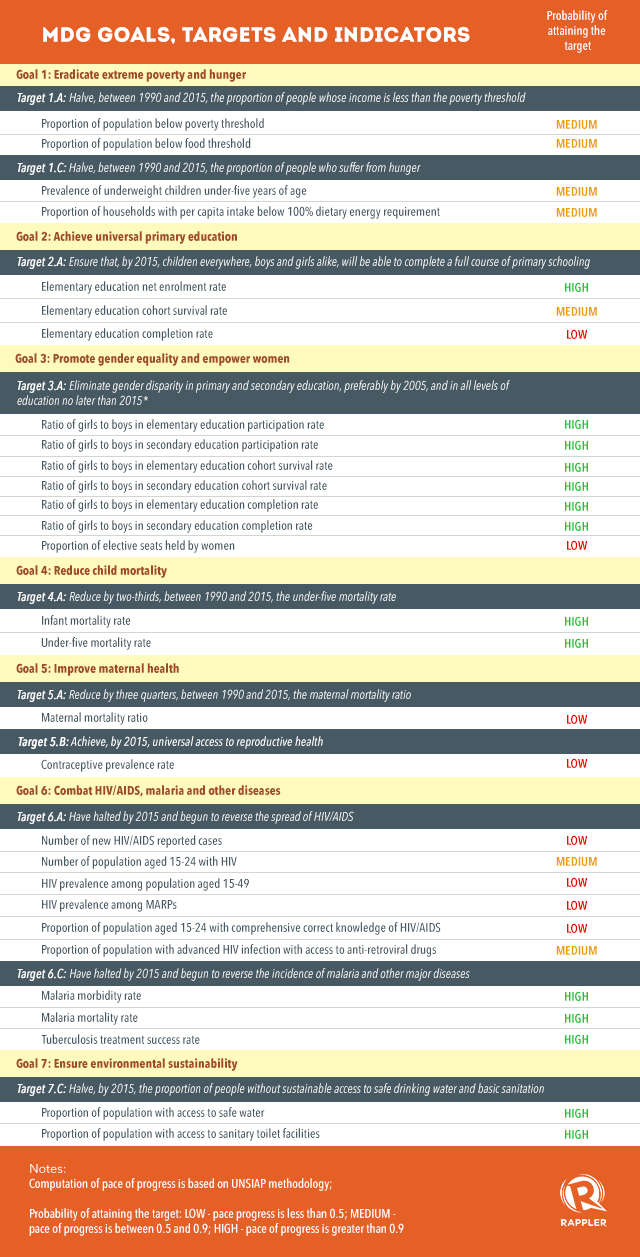SUMMARY
This is AI generated summarization, which may have errors. For context, always refer to the full article.

MANILA, Philippines – With 2015 just around the corner, can the Philippines meet the targets set forth by the United Nations Millennium Development Goals (MDGs)?
According to the 5th Philippine Progress Report on the MDGs launched on Wednesday, August 20, the Philippines has a good chance of meeting half of the 8 MDGs.
These 4 MDGs are:
- Achieving universal primary education
- Reducing child mortality
- Promoting gender equality
- Ensuring environmental sustainability
The Philippines has also surpassed the 2015 target of halving the proportion of people with no access to basic sanitation.
However, the Philippines only has a “medium probability” of ending income poverty and malnutrition among children. (READ: ‘Slow improvement in PH quality of life’)
The country has a “low probability” of improving maternal health and combating HIV/AIDs.
There were also specific aspects of the education and gender equality MDGs which the Philippines has a low probability of solving:
- Ability of schools to keep students from dropping out
- Gender inequality when it comes to political participation
Here are the MDG targets and indicators taken from the executive summary of the progress report:

Education targets
The particularly rosy aspect of the campaign for universal primary education is the country’s net enrollment ratio (NER).
The NER is the number of students in a certain age group meant for a certain education level out of the total population of that age group. The higher the NER, the higher the enrollment of the school-age population.
In 2012, the Philippines achieved 95.2% NER from 85.1% in 1991 showing an improvement of 10.1%. However, the 2012 NER was a step down from the 2011 NER which was at 97.3%.
But the likelihood that grade 1 students finish elementary school is another matter. Measurements of this – cohort survival rate (CSR) and completion rate (CompR) – are at 75.3% and 73.7%, respectively. (READ: MDG progress slow despite CCT program)
Education Secretary Bro Armin Luistro told reporters that almost all school-aged children are in school.
Based on his estimate, around 98% to 99% of the 25 million Filipinos aged 5 to 17 years old are enrolled.
There are students who drop out because of health concerns. But the real problem are kids who are not even allowed to go to school by their parents.
“There may be issues of child labor, child trafficking or simple ignorance on the part of the parents. That’s why we need the help of barangays to go door-to-door checking if the kids are going to school,” he said.
Infant, maternal mortality
It is also highly probable that the Philippines can achieve the 2015 target of reducing the mortality rate of children under 5 by two-thirds.
In 1990, the number of children under 5 who died was 80 out of 1,000 live births. In 2011, the number decreased to 30, not far from the 2015 target of 26.7.
In 1990, the number of infant deaths was at 57 per 1,000 live births. In 2011, the number was down to 22. The 2015 target is 19.
But the same forecast for improving maternal health is not as sunny.
According to the report, the maternal mortality ratio even increased from 209 deaths per 100,000 live births in 1990 to 221 deaths in 2011. The country has a year left to bring that number to the target: 52.
The Philippines also has a low chance of meeting targets to combat HIV/AIDs. Though prevalence of the disease is still less than 1%, the number of new HIV cases has been increasing.
There were only 66 HIV/AIDs cases reported in 1990 while in 2013, the number was at 4,814.
Meanwhile, the Philippines is winning the fight against tuberculosis and malaria. For both these diseases, mortality rate was reduced from 1990 to 2011.
Tuberculosis mortality rate was at 58 in 100,000 people in 1990. In 2011, it was slashed to 29.
Malaria mortality rate was at 1.5 deaths per 100,000 people in 1990. In 2012, the number was brought down to 0.01.
Poverty, hunger
The Philippines has a “medium probability” of meeting the Millennium Development Goal of eradicating extreme poverty and hunger.
As of 2012, the poverty incidence among the population was at 25.2%. While it is an improvement from the 34.4% figure in 1991, it’s still not close to the 17.2% target for 2015. (READ: What’s next for hunger and poverty after 2015?)
The progress report also reflected the discrepancy between the country’s growing gross domestic product (GDP) and the employment rate.
While the GDP grew from 6.8% to 7.2% from 2012 to 2013, the employment rate decreased in the same period from 1.1% to 0.8%.
The Philippines needs to work harder to fight hunger. The 2011 prevalence of underweight-for-age children under 5 years old was at 20.2%. By 2015, that number must be brought down to 13.6%.
There are also still plenty of families which eat below the dietery energy requirement. In 2008, 66.9% of households fell under this category – far from the 37.1% target in 2015.
‘Green’ achievements
The Philippines can be proud of its commitment to the Millennium Development Goal of ensuring environmental sustainability.
The Philippines has surpassed its 2015 target to ensure that 83.8% of the population has access to sanitary toilet facilities, claims the report.
As early as 2011, 91.6% of the population was said to have access to clean toilets.
The country is also on track in ensuring 86.5% of the population has access to safe water by 2015. In 2011, 84.4% of the population already enjoyed such access.
The Philippines has also increased its forest cover from 20.5% of the country’s total land area in 1990 to 22.8% in 2010. However, the 2010 figure was a drop from the forest cover in 2003 which was at 23.9%.
This means that from 2003 to 2010, the country lost 4.59% (more than 320,000 hectares) of forest cover.
The Philippines also increased the area protected to maintain biological diversity. The ratio of protected area to surface area in 1990 was 8.30. It grew to 14.09 in 2010.
The MDGs are 8 international development goals established in 2000 to serve as a guide for countries in setting priorities to improve the lives of their citizens.
The UN’s 193 member-states have committed to achieving targets under these goals by 2015. A new set of goals will be crafted in a high-level summit in September 2015. – Rappler.com
Add a comment
How does this make you feel?
There are no comments yet. Add your comment to start the conversation.